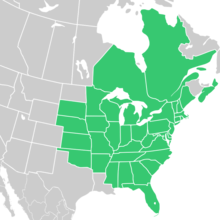Symphyotrichum pilosum
| Symphyotrichum pilosum | |
|---|---|

| |
| S. pilosum var. pilosum | |

| |
| S. pilosum var. pringlei | |
| Scientific classification | |
| Kingdom: | Plantae |
| Clade: | Tracheophytes |
| Clade: | Angiosperms |
| Clade: | Eudicots |
| Clade: | Asterids |
| Order: | Asterales |
| Family: | Asteraceae |
| Genus: | Symphyotrichum |
| Subgenus: | Symphyotrichum subg. Symphyotrichum |
| Section: | Symphyotrichum sect. Symphyotrichum |
| Species: | S. pilosum
|
| Binomial name | |
| Symphyotrichum pilosum | |
| Varieties[2] | |
| |

| |
| Native distribution[3][4] | |
| Synonyms[2] | |
|
Basionym
show
Alphabetical list | |
Symphyotrichum pilosum (formerly Aster pilosus), commonly called hairy white oldfield aster[5] or frost aster,[6] is a flowering plant in the family Asteraceae native to central and eastern North America. It is a perennial, herbaceous plant that may reach 20 to 120 centimeters (8 to 47 inches) tall. Its flowers have white ray florets and yellow disk florets.[7]
Distribution and habitat[]
It is native to central and eastern North America, where it is found in Canada and the United States.[7] It is widespread and common throughout its range. Its natural habitat includes communities such as prairies, open woodlands, and outcrops. In general, it responds positively to disturbance, and is often seen occupying sunny, weedy habitats.[8][9]
Taxonomy[]
Two varieties are recognized, although determining the best taxonomy for this group is difficult due to polyploidy and hybridization.[10] The two currently recognized varieties are as follows:[7]
- S. pilosum var. pilosum — stems and leaves hairy, widespread and often weedy
- S. pilosum var. pringlei — commonly called Pringle's aster;[4] stems and leaves mostly smooth, found on alvars, cedar glades, and sand dunes[8]
Cultivation[]
Symphyotrichum pilosum var. pringlei[11] and its cultivar 'Ochtendgloren'[12] have both won the Royal Horticultural Society's Award of Garden Merit.[13]
Citations[]
- ^ NatureServe 2021.
- ^ Jump up to: a b c POWO 2019.
- ^ Brouillet et al. 2006, var. pilosum.
- ^ Jump up to: a b Brouillet et al. 2006, var. pringlei.
- ^ USDA, NRCS 2014.
- ^ BSBI 2007.
- ^ Jump up to: a b c Brouillet et al. 2006.
- ^ Jump up to: a b Semple 2014.
- ^ Chmielewski & Semple 2001.
- ^ Yatskievych 2009.
- ^ Royal Horticultural Society n.d.a.
- ^ Royal Horticultural Society n.d.b.
- ^ Royal Horticultural Society 2017.
References[]
- Brouillet, L.; Semple, J.C.; ; ; (2006). "Symphyotrichum pilosum". In Flora of North America Editorial Committee (ed.). Flora of North America North of Mexico (FNA). 20. New York and Oxford. Retrieved 18 July 2021 – via eFloras.org, Missouri Botanical Garden, St. Louis, MO & Harvard University Herbaria, Cambridge, MA.
- BSBI List 2007 (xls). Botanical Society of Britain and Ireland. Archived from the original (xls) on 26 June 2015. Retrieved 17 October 2014.
- Chmielewski, J.G.; Semple, J.C. (2001). "The biology of Canadian weeds. 114. Symphyotrichum pilosum (Willd.) Nesom (Aster pilosus Willd.)". Canadian Journal of Plant Science. 81 (4): 851–865. doi:10.4141/P00-074.
- NatureServe (2 July 2021). "Symphyotrichum pilosum White Heath Aster". NatureServe Explorer (explorer.natureserve.org). Arlington, Virginia: NatureServe. Retrieved 18 July 2021.
- POWO (2019). "Symphyotrichum pilosum (Willd.) G.L.Nesom". Plants of the World Online (www.plantsoftheworldonline.org). Royal Botanic Gardens, Kew. Retrieved 18 July 2021.
- Royal Horticultural Society (n.d.a). "RHS Plant Finder - Symphyotrichum pilosum var. pringlei". Royal Horticultural Society (www.rhs.org.uk). London: Royal Horticultural Society. Retrieved 5 March 2021.
- Royal Horticultural Society (n.d.b). "RHS Plant Finder - Symphyotrichum 'Ochtendgloren' (pilosum var. pringlei hybrid)". Royal Horticultural Society (www.rhs.org.uk). London: Royal Horticultural Society. Retrieved 30 November 2018.
- Royal Horticultural Society (July 2017). "AGM Plants - Ornamental" (PDF). London: Royal Horticultural Society. p. 95. Retrieved 30 November 2018.
- Semple, J.C. (29 January 2014). "Symphyotrichum pilosum —Oldfield Aster, Frost Weed, Hairy or Hairy White Oldfield Aster". University of Waterloo (UWaterloo.ca). Waterloo, Ontario: University of Waterloo. Retrieved 18 July 2021.
- USDA, NRCS (2014). "Symphyotrichum pilosum". USDA PLANTS Database (plants.usda.gov). Natural Resources Conservation Service PLANTS Database. USDA. Retrieved 7 December 2015.
- , ed. (9 July 2009). "Symphyotrichum pilosum". Flora of Missouri. Missouri Botanical Garden – via Tropicos.org.
- NatureServe secure species
- Symphyotrichum
- Flora of the Eastern United States
- Flora of Canada
- Plants described in 1803
- Taxa named by Carl Ludwig Willdenow
- Astereae stubs
